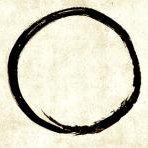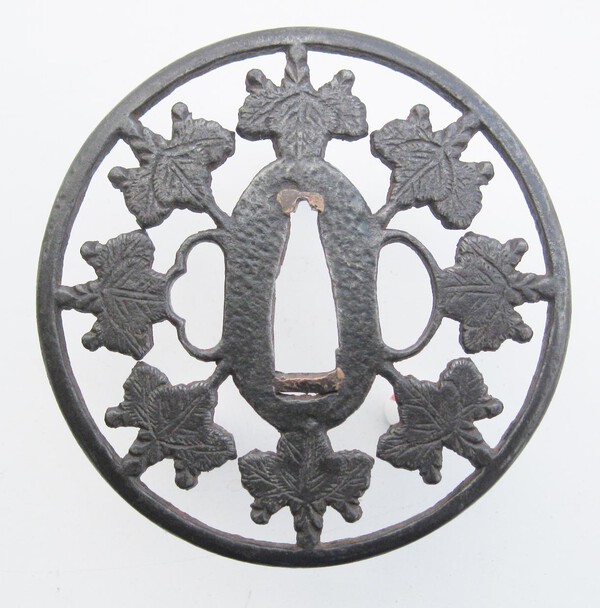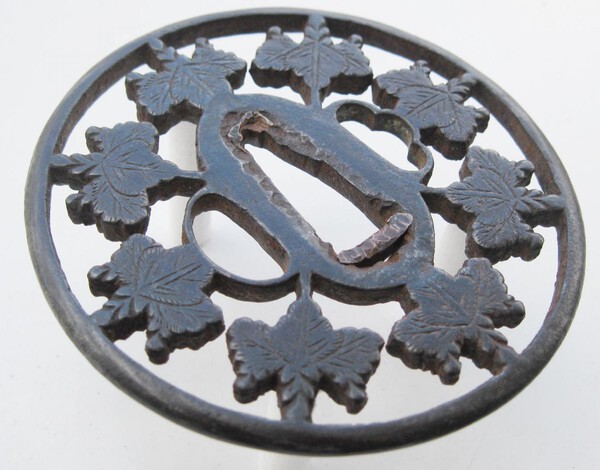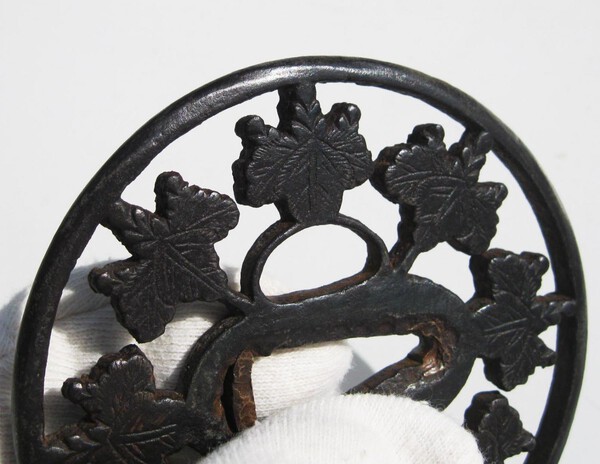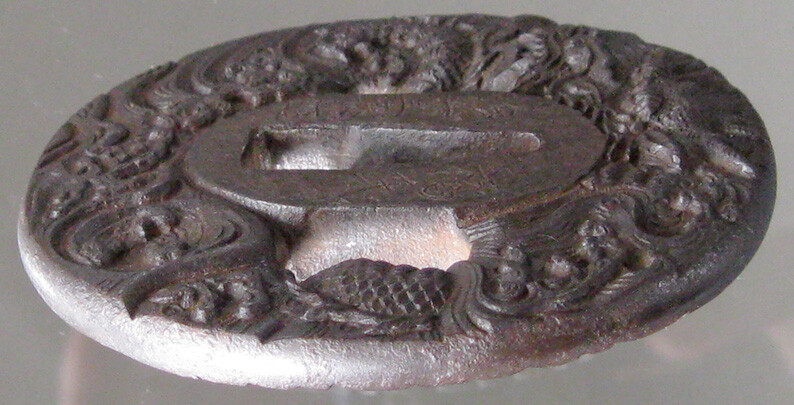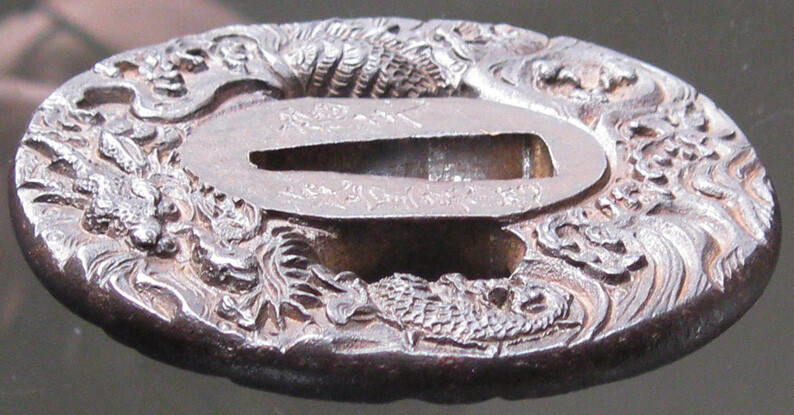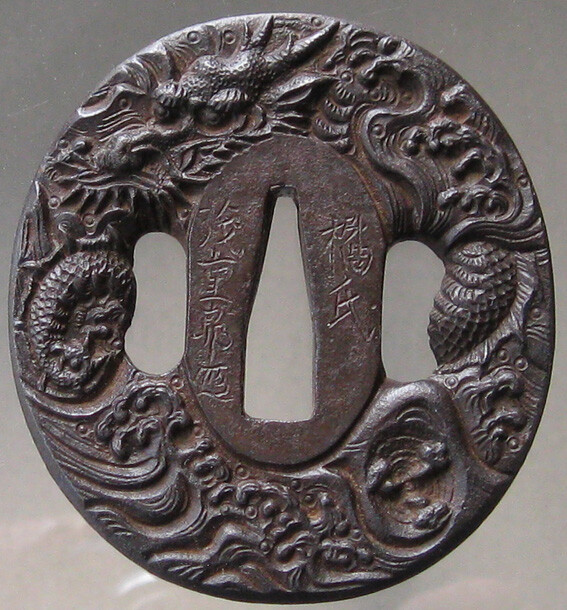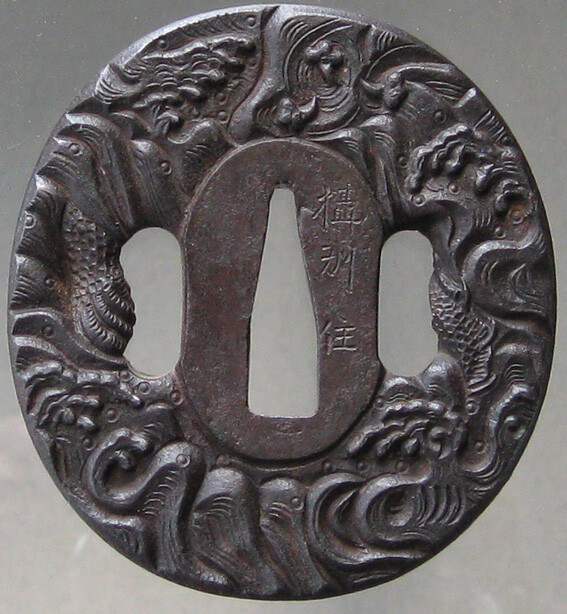-
Posts
381 -
Joined
-
Last visited
-
Days Won
1
Content Type
Profiles
Forums
Events
Store
Downloads
Gallery
Everything posted by FlorianB
-
Meanwhile I’m wondering, too, about the request. Do You want to get in contact with collectors of this special topic to exchange experience and knowledge? Sincerly, Florian
-
Shoami, yes, this COULD BE the ultimate answer, but not a satisfying one, I’m afraid. Nice try, Mauro. Mikolaj, a gorgeous collection, I’m deeply impressed! Arnold, I agree with you that the curvature in the upper part of the seppa dai differs on each side. This was a helpful advice! In future I will pay more attention to a carefully examination of seppa-dai. Finally, what do You think about the tekkotsu? Does it go with Kyo? I remember a similar discussion in which the apperance of tekkotsu was the decisive clue for an Owari-attribution. Sincerly, Florian
-
Thanks for Your replies. Concerning the quality: IMHO it is a very good tsuba and this is the opinion of our leading german expert, too. Although I must admit the difficulty to assess the tsuba by my moderate pictures. I understand that the pictures by Mikolay show all the same tsuba, on one hand offered as Kyo-Sukashi - and as an example for Owari on the other hand. Well, You see my problem... However, it is interesting to compare both pieces. The shape of the kiri on the tsuba in Mikolaj's post appear in my eyes more like Kyo, but the seppa-dai and the ryo-hitsu hint to Owari. Furthermore the herein mentioned time offers a wider range. I think, if it is Owari it can't be older than early Edo, if it is Kyo it could be earlier, around Momoyama. Thanks thus far, Florian
-
Gentlemen, I want to show You a Tsuba. The size is 81 x 82 mm / 3,18” x 3,22”, the thickness 4,8 mm / 0,18”. There is no niku and the surface has a moist look (uruoi). My first impression was Kyo-Sukashi because of the thin plate, the small, rounded rim and the sumptuous composition. The hitsu-ana, too, appear a little bit squeezed. However, the design lacks the elegance and airiness of Kyo. The kiri look more like those I’ve seen in Owari-works. Furthemore, twisted-looking linear tekkotsu partially are seen in the rim. After all - Owari? I’m puzzled... I would be grateful to get Your opinions. Sincerly, Florian
-
Hi Florian, I think, there’s no need to change signature. Latetly I’m not very active at the NMB and if we are mixed up - so what? If You like to exchange thoughts feel free to send me a mail. FlorianB
-
Dear Eric, dear Florian, I have to admit that I am the guy who wrote the lines about the “Aesthetics in Japanese Sword” and I’m honoured to read that You appreciate my thoughts. Maybe You know that since the 1980s a lot of papers had been issued in the NBTHK-EB by several members. However, nearly all those articles deal with the technical aspects of Nihonto and as long as I am interested in the Japanese Sword I struggled with its artistic value. At least I tried to put my own ideas in the paper mentioned above and published it several years ago for both the members of the NBTHK-EB and the Nihonto Club. Later I also enclosed it slightly modified in the german edition of the first NC cataloge. Your comments suggest that my lines are of a certain use. Finally, it is interesting to have a namesake in this message board who starts his own efforts to gain knowledge in Nihonto. FlorianB
-
Thank You all for Your opinions. At least I’m not disappointed because as I mentioned before this tsuba is just of secondary interest for me. It is part of a koshirae stored away for about ten years and was „rediscovered“ recently while searching for a carving work. Just because of the extensive signature and my uncertainty of the quality I thought it could be an interesting piece for discussion. Now I’m wiser - and that’s what I gained for! Greetings, Florian
-
I’m sorry that I’m still harping on the quality. Could there be any details specified which prove the quality or is it necessary to compare this piece with other ones to get an impression? Yours, Florian
-
Hi Guys, thanks for Your responses. At first I want to point out that I’m not fishing for compliments - thanks anyhow . Secondly, two additional photos: To specify my problem, I learned that the more detailed, precise and deep a carving is the better is the workmanship and thus the quality. In this tsuba I see a discrepancy between the shaping of the dragon and the mould of the waves. IMO due to the plain rim the tsuba appears to be incomplete, too. Did the maker lost his interest or did a student collaborate? Or are there practical or aesthetic reasons (i.e. an intentional contrast)? Greetings, Florian
-
Hello everybody, I want to show You a tsuba I own, probably from the late Edo period. The measures are 7,3 x 6,7 cm (about 2,88 x 2,64 inch) , thickness of the seppa-dai is 0,75 cm (0,295 inch). It is signed „Shigejuro“ or „Mojuro“ (thanks, Markus, for translation help!) with Kakihan, „Tachibana uji“ and on the reverse „Sesshu ju“. Because Tsuba are an ancillary interest of mine I have only a few reference books and I wonder if anybody can give me some facts about this man? My second question concerns the quality of this piece. On the one hand the body of the dragon is precisely cut and shaped, on the other hand the modeling of the waves appears to be flat in spite of the thickness. Furthermore, the design runs vividly through both ana, the rim, however, is plain. I would be grateful to hear Your opinions. Florian
-
In my opinion this tsuba was made as it is depicted. If You imagine the folded area flat again, there would be a considerably larger space below the nakago-ana so there would be an distinctly unbalance. In a symbolistic way the crooked and bend design could emphasize a destructive impression. Without a practical purpose it is of course a bizarre collector’s item from later Edo-Period. Greetings, Florian
-
-
Checking about two dozens of Ozaki Suketaka's mei by different resources I can confirm it's a gimei - and, alas, not even cleverly done. Eric's pictures display a grass style writing, Suketaka also inscribed his signatures with more formal kanji. However, this wakizashi signature seems to be an odd mixture of both. Florian
-
Katanoko, please be so kind and specify the measurement of the blade (nagasa, mihaba, kasane). A large dimensioned blade isn't unusual for Shin-Shinto and without any proper description it is difficult to judge just by the pictures alone. In the first picture I even got the impression that the blade becomes broader towards the monouchi - THIS would be rather unusual. Some more pictures showing the hada and hamon would help,too, - I can see just a long kaeri, which indeed hints to Suketaka. Concerning the mei I've got my doubts, especially the third kanji from below looks curious, but I'll have to do some research. Florian
-
Hello Jock, the Tsuba looks definitely to small for this Katana, it's probably a Wakizashi-Tsuba. Furthermore, because of its small size the seppa seem to cover partly the hitsu-ana. Such Tosho-style Tsubas were often made during the Edo Period easy to recognize on the basis of the tapering at the rim and the placement of the sukashi in the middle of the plate. The exactness of the sukashi hints to a later period, too. However, the tsuka is well made with an interesting wrapping. Just try to get another Tsuba. Greetings, Florian
-
It's very interesting what You found out concerning the proportions of this blade. However, allow me the remark that this sword has been shortened and repolished and the original measures would be different ones. But nevertheless, of course it could be the polisher's idea. Although it seems beguiling to discover metric rules of blade-design please keep in mind, too, that through history blade proportions changed by personal taste, practical use, later alteration and last but not least because of fashion. So even the standardised definitions how a blade has to look like at a particular period or area are only general because of a great amount of exceptions. I want to note the term "koroai" (meaning "just right") for describing a blade - alas, no measures (like "golden ratio") are used but the impression onto the viewer that proportions looks perfect in all respects. Florian
-
Please remember that the appraisal of a Japanese blade based on one hand upon the aesthetic appearance but on the other hand upon the practical value. Of course no one will fight with a sword today, but in recent times where life depended on a capable weapon a hagire showed the blade could break or chip. That's why even today hagire are notorious. About ten years ago I possessed - and enjoyed - a hagire blade myself but later I was glad to get rid of it because every sword connoisseur I showed the blade teared it into pieces because of the hagire. If You are only interested in the aesthetics, a blade with hagire MAYBE COULD be acceptable as a study blade as mentioned above but You must realize it will always be "the blade with a hagire" in Your collection and (I'm afraid to say) in sword circles it will be infamous, too. My advice: if You own a blade with hagire don't show it to anybody or sell it again soon. FlorianB
-
Hello Andreas, thanks for this very interesting picture of Naotane's Tanto. The kitae looks indeed very similar! Though I checked informations about Naotane, alas, I haven't found anything mentioned concerning such jigane. As Eric points out, Naotane reproduced different styles, but I'm puzzled just more over the connection between my late Muromachi kitae and a Shin-Shinto-kitae. At least I'm appeased that such kitae, although unusual, could be found occasionally on Japanese blades even on high quality ones like the mentioned Rai Kunitsugu and this magnificent Naotane. FlorianB
-
I want to introduce a tsuba which isn't worth mentioning because of the artistic value but maybe as a historical evidence. It measures 6,1 x 5,5 cm i.e. 2,4" x 2,16" . As You can see the plate is in Ito sukashi style (signed Yukiyoshi or Koreyoshi) but later four aoi-mon (four more identically on the reverse) have been added which of course don't match the original design. Note also the lack of accuracy in placement, although necessary because of the space. In my opinion (if I'm allowed to speculate) this tsuba was owned by a samurai who became a retainer of some Tokugawa clan and needed a formal fitting. Yet he couldn't afford a proper made formal tsuba so he let altered this one he possessed. Thus it seems to be a symbol for the increasing poverty of the samurai in the Edo-Period. Or am I wrong and such procedure was usual? I wonder if there are other similar modified tsuba or fittings because I haven't seen any. Alas, in literature only the better pieces are displayed, rarly the common ones (whatever common means). Florian
-
Sil, another serious advice: both the aesthetics of a Japanese blade and the decisive hints to it's maker could only be revealed in polished condition. I'm afraid, that Your blade hasn't the proper condition now to tell more than general ideas and speculations even with better photos. However, polishing is very expensive, but money is wasted if the blade turns out (in worst case) worthless. It is not my intention to discourage You but try to get in personal contact with collectors and show this blade to someone who is experienced (REALLY experienced) and could advise You if further investments should be made. And maybe this person could tell You more about the origin, holding this blade in his hands. FlorianB
-
Eric, of course You’re right. The comparision between the pictures of the enlarged blade and the persian blade does not work properly. By the way: moto-kasane 0,6 cm. Florian
-
Hector, nice try, but namazu-hada or sumigane made by Aoe is a completly different hada. Look at some pictures on the Usagiya site You mentioned: http://www.ksky.ne.jp/~sumie99/sword14.html Florian B
-
Thanks for Your responses. First, I'm aware of the fact, that the blade was altered. Because the lower hole is the original, accompanied by some higaki yasurime in the lower third of nakago, I think, the original length must be about 20 cm. The blade must have been broader, too. Why not Mino? Well, the existence of dark steel, the nie-deki hamon without any togari (although a great amount of activities), pointed boshi, bo-utsuri - all these speak in my opinion against Mino. I assumed this blade may be Sue-Naminohira (ok, the bo-utsuri doesn't fit). However - these are my personal considerations. Finally, I do not doubt NBTHK-papers in general but in this special case I think because of the dating there's someone quick at hand with a Sue-Mino-attribution. Further studies are needed... Florian B.
-
Maybe You get a better idea of this blade (and the proportion of the enlarged kitae above) by an additional complete view with measurements: Florian B.
-
Hello everybody, I'm new to the NMB (though not new to the Nihonto). As You can see on the picture below (poor quality, but I think You'll get the point) there's a small blade displaying all over a very remarkable but exceptional kitae. Obviously two steels of different carbon content are assembled and welded together. In addition there’s an itame-nagare hada. I was told the kitae resembles to western Wootz steel. However, it’s a Muromachi blade with a Hozon-paper attributing the dirk to Sue-Mino (although I dare to doubt the Mino origin...). Because of the small size, alteration and repeated polishing it seems obvious there’s no core steel. Can anybody help me with some information about such a kitae and/or similar examples? Florian B.


